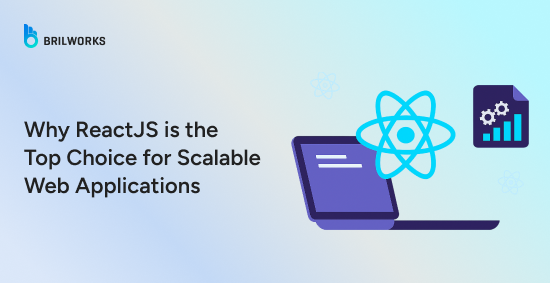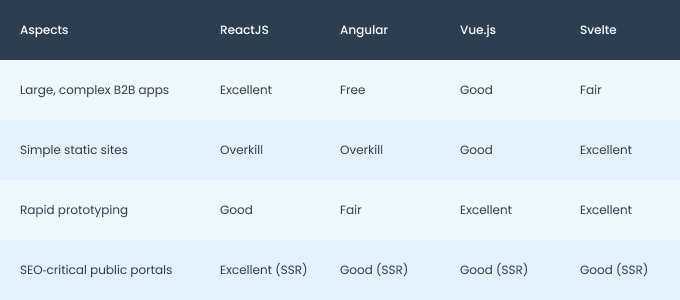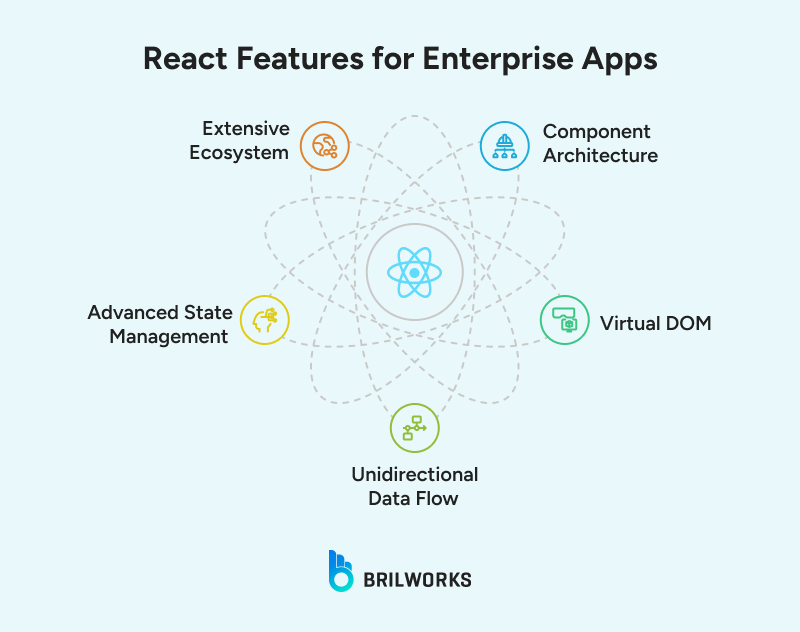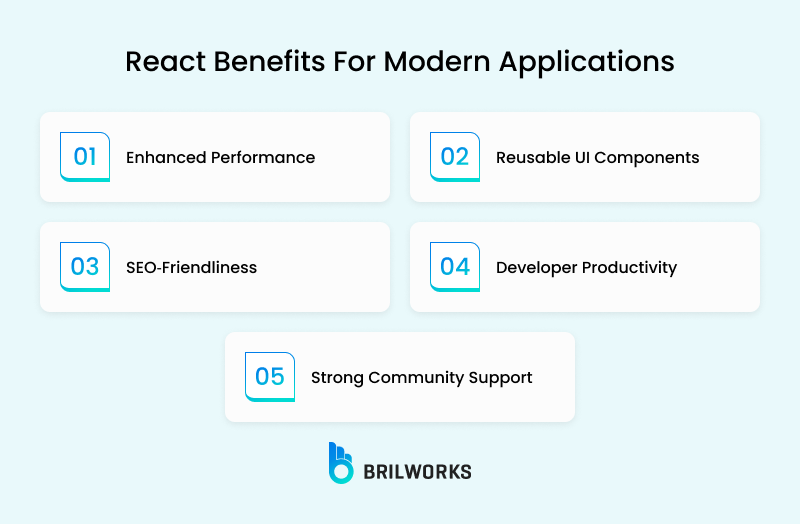COOPERATION MODEL
ARTIFICIAL INTELLIGENCE
PRODUCT ENGINEERING
DevOps & Cloud
LOW-CODE/NO-CODE DEVELOPMENT
INDUSTRY
FRONTEND DEVELOPMENT
CLOUD DEVELOPMENT
MOBILE APP DEVELOPMENT
LOW CODE/ NO CODE DEVELOPMENT
EMERGING TECHNOLOGIES








Enterprise applications aren't developed with end-users in mind. They're usually built to improve business operations, give decision-makers visibility, or bring structure to scattered operations.
Since its release in 2013, React has become a go-to framework for web development projects. The reason is its architecture, a component-based model, which aligns well with today's enterprise requirements.
ReactJS is a top choice for modern web applications in 2025 due to its component-based architecture, fast rendering, and developer-friendly ecosystem.
Whether you’re building enterprise-grade applications or B2B solutions, React provides the flexibility and scalability modern web apps demand. What makes React suitable for enterprise-grade B2B apps is the way it handles layered interfaces, routing, and rendering.
As you know, business-facing application UI needs to be predictable and render ultra-fast. React ships a multitude of features, saving a lot of time for web engineers.
You don't need to build a form handler or routing logic from scratch; it's already there. You can skip basic feature writing and even build in a few hours by using standard UI templates. What's more, React's modular architecture separates logic and UI, state management, and many other components into reusable pieces.
It means if you have built one feature, you will not need to create it again. From a company owner's perspective, multiple teams can work on a single project to build different layers.
The hiring of web developers also gets easier. It's JavaScript. Millions of developers already know it, and the number of companies with production experience in React continues to grow.

You can pair React js with whatever routing, state management, or build tools. Vue and Solid are similar in terms of flexibility. The difference is that React's ecosystem has matured around this flexibility, with a large number of third-party tools and patterns that support it.
Vue, Svelte, Angular, and even newer entrants like Qwik all use component-based models. React js is popular not only for component-based architecture but also for how early and thoroughly it internalized this model.
React's community is huge, and Meta's continued backing gives it long-term credibility. That said, Angular has Google, and Vue has strong community stewardship. The combination of corporate support and a large, active community gives React both long-term stability and rapid innovation, so you get the best of both worlds: reliable foundations and cutting-edge tooling.
In React, UI elements are packaged into reusable blocks. This isolation means the team can ship features in parallel.
Benefits for enterprise teams:
Multiple teams can build components.
Isolated updates.
Even so, frameworks like Vue and Angular still compete; teams sometimes prefer Vue's single-file component syntax or Angular's all-in-one structure when they value convention over composability.
Under the hood, React features a lightweight copy of the UI tree (the Virtual DOM) and diffs it against the real DOM to update UI. For heavy user interfaces, where thousands of components might update in rapid succession, the Virtual DOM updates only the part of the change rather than a complete and resource-expensive UI update.
React forces parent components to pass data down via props, and children signal changes up via callbacks. This way, React simplifies reasoning and debugging.
React provides a centralized solution for state management, allowing developers to manage a global state in one place. Plus, Redux remains a gold standard for the global state. In addition, its built-in Context API is highly praised for static global data.
It is lightweight and doesn't require external libraries. Plus, libraries like Zustand, Jotai, and MobX are appealing to startups or teams that want to move fast.
React's longevity (nearly a decade old) has spawned an ecosystem that few rivals match.
Ecosystem: Why It Matters for B2B
React Router supports complex, nested, and role-based navigation structures often needed in enterprise apps
Material UI offers pre-built, accessible components that reduce UI development time and ensure consistency
Jest + React Testing Library (RTL) provides reliable, maintainable testing with strong community support and snapshot capabilities
Storybook allows teams to develop, test, and document components in isolation, which is especially useful for multi-team collaboration
React DevTools helps identify performance issues by profiling components and tracking re-renders
The 2024 State of JavaScript survey found React still sitting at the top alongside Vue and Angular, each launched over ten years ago.

React delivers a smooth experience even when users sift through thousands of records. Its virtual DOM ensures only the parts of a page that change are re‑rendered, so actions like sorting or filtering large data sets feel instantaneous.
That speed translates directly into fewer delays for sales reps or account teams, boosting their output and cutting down on frustration. In one B2B CRM, switching to React cut the average page load by nearly half, helping reps handle more calls and close deals faster.
Building once and using it everywhere drives both consistency and cost savings. When your team develops a data table or a user‑management panel as a standalone component, it slots into every module without extra work.
That reuse means fewer hours spent on repetitive coding and fewer visual hiccups for end users. Over time, a curated library of components becomes your brand's single source of truth, so every portal, report, or dashboard feels familiar from day one.
Modern React frameworks solve the old problem of search engines missing content hidden behind client‑side code. Server‑side rendering serves up complete page markup so crawlers index all your partner portal or documentation pages right away.
Tools like Next.js offer this out of the box, letting your marketing or partner‑success teams publish updates that show up in search without extra configuration. The result: better visibility for public B2B resources and more inbound interest from potential collaborators.
React's conventions and ecosystem let teams move fast with fewer surprises. A broad talent pool means hiring skilled developers is smoother, and features like hot reloading give instant feedback on UI tweaks. Built‑in testing utilities and strong style guidelines help catch issues before they reach users.
Altogether, faster sprints and higher‑quality code lower the risk of defects in production and let your roadmap keep pace with evolving customer needs.
Backed by Meta and a global network of contributors, React benefits from constant scrutiny and innovation. Security patches and performance tweaks land quickly, shielding your applications from known vulnerabilities.
When your team hits a roadblock, an abundance of tutorials, forums, and open‑source libraries means answers are just a search away. That ecosystem reduces reliance on any single vendor and helps ensure your platform stays current as requirements shift.

Even the most versatile toolkit has its edge cases. Here are a few scenarios where you might weigh other options:
If your site is nothing more than a handful of pages with minimal interactivity, think brochure sites or lightweight landing pages, bringing in React's runtime and building complexity can feel like using a freight train to deliver a letter.
For ultra‑lean experiences where every kilobyte and millisecond counts (for example, on low‑powered IoT devices or ultra‑fast microsites), frameworks with zero runtime or smaller bundles (like Svelte or plain HTML/CSS) can achieve faster first‑byte and first‑paint times.
A team already fluent in Angular, Vue, or another framework can often deliver features faster within their familiar stack. Retraining or hiring specifically for React may introduce delays that outweigh any long‑term benefits.
When integrating with older server‑side platforms, proprietary UI toolkits, or highly specialized systems, the overhead of bridging React with those environments can offset its advantages.

When you choose a ReactJS partner, you're not just outsourcing code; you're investing in years of hard‑won expertise. At Brilworks, we've guided dozens of B2B teams past the usual pitfalls of component design, performance tuning, and long‑term maintainability.
We know that the best collaboration feels less like vendor management and more like an extension of your own team.
That's why we take the time to understand your unique challenges, whether it's integrating with legacy systems, optimizing server‑side rendering for SEO, or building out a custom design system that reflects your brand. By partnering early and often, we ensure each sprint delivers value and keeps your roadmap on track.
Ready to turn ReactJS into a true competitive advantage? Hire dedicated React experts or a team to build your next application.
ReactJS is a popular framework for modern web development because it offers a component-based architecture, fast rendering via the Virtual DOM, and a rich ecosystem of tools and libraries. Its flexibility and strong community support make it ideal for building scalable enterprise and B2B applications.
ReactJS helps enterprise applications by enabling reusable UI components, improving performance with virtual DOM, supporting unidirectional data flow, and simplifying state management. Teams can collaborate more efficiently, build faster, and maintain consistency across complex applications, making React a top choice for large-scale web projects.
ReactJS, Angular, and Vue each have strengths. React excels in flexibility, reusable components, and a large developer community. Angular provides an all-in-one solution with strong structure, while Vue offers simplicity and ease of integration. For enterprise-grade modern web apps, React’s ecosystem and scalability often make it the preferred option.
Get In Touch
Contact us for your software development requirements
Get In Touch
Contact us for your software development requirements